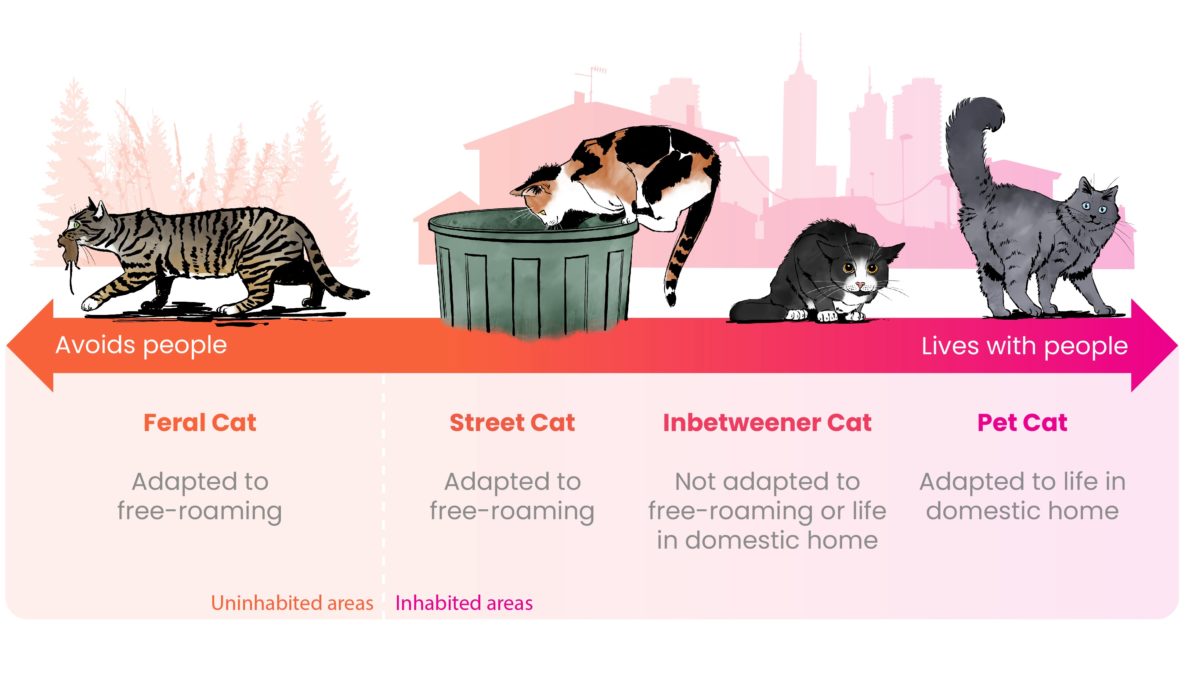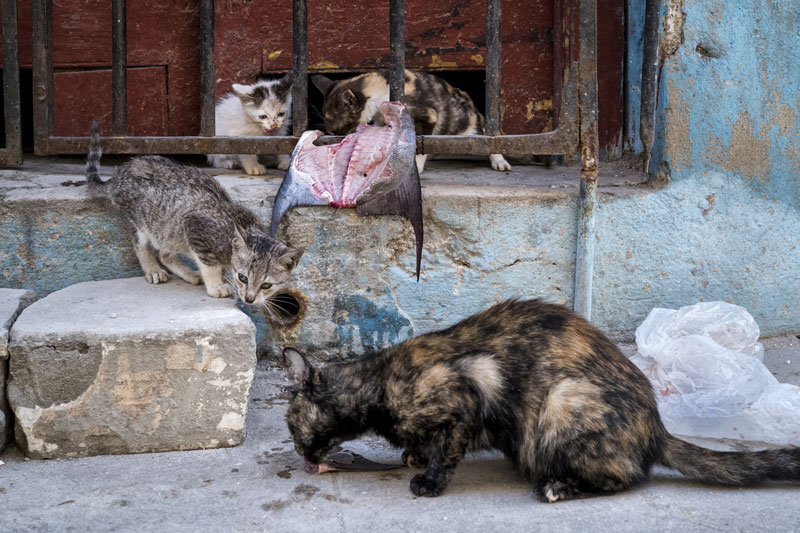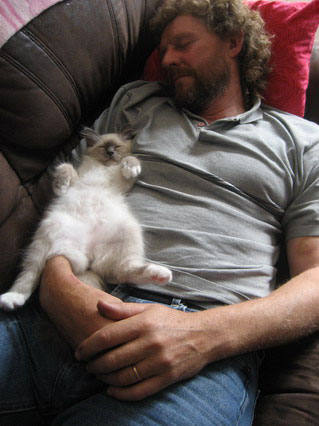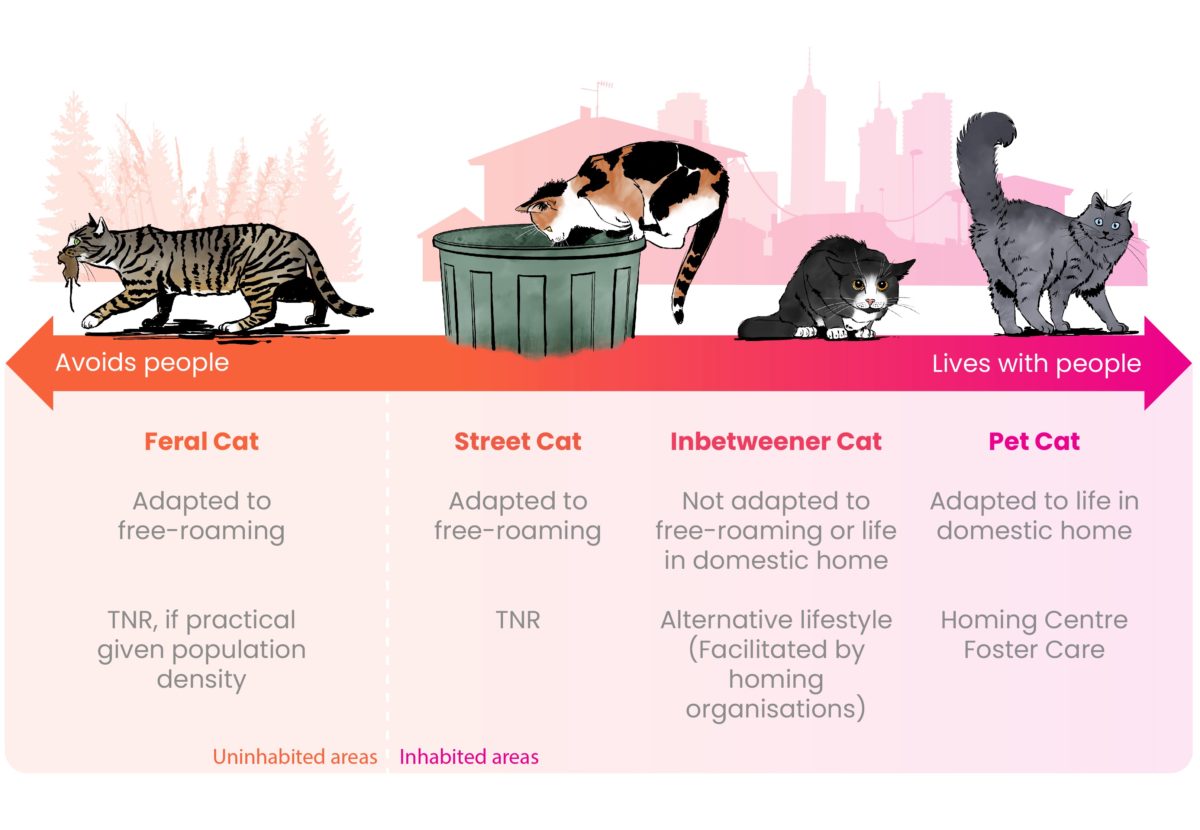The different needs of domestic cats
Download our Cat Friendly decision-making documents:
Feral, street and pet cats are all the same species (domestic cat, Latin name: Felis catus). This does not mean, however, that they are all the same in relation to their needs and desire to live closely with people and we have to consider this carefully in deciding how we can help them for the long term.
Let’s look at the range of ways in which cats live, from the feral cat that is free-roaming and survives by hunting and avoiding all contact with people, to the pet cat that is happy to share our homes and company. In between the two ends of this range are cats that live alongside people with varying amounts of contact and different reactions to being near people, from pleasure, to fear and distress.
| See the ISFM Guidelines on Population Management and Welfare of Unowned Domestic Cats (Felis catus) |

What influences where cats sit within this range?
Pet cats are made, they are not born that way!
- The temperament of a cat is shaped by its genes (traits passed down by parents) and the environment it is brought up in. Cats that are friendly are likely to pass on this trait to kittens – many pedigree cats are chosen for their friendliness to people and this can be seen in their behaviour; alternatively, street cats living independently will be more alert to danger including potential threats from humans – this may be because they are naturally more reactive to people and less relaxed in their company.
- If a cat is going to live comfortably with people when it grows up it is essential for the kitten (between the ages of two and eight weeks) to have positive experiences with a number of people. At this time kittens are most receptive to learning about their surroundings and their own and other species (this period is referred to as the sensitive period – some people refer to this process as early socialisation). You will need to know this because you will undoubtedly have kittens in your care from time to time, or take in pregnant cats, so if you intend them to be adopted as pets you will need to ensure they get the early experiences they need. This shapes the cat’s response to people for life.
- Kittens also need positive exposure to new and different situations. Exposure to sights, sounds and smells that are common in a home environment, such as televisions, computers and vacuum cleaners equips the kitten with an understanding that these things are not to be feared. If you are running a homing centre, this may mean trying to place kittens and pregnant queens with foster carers who can provide them with the experiences they need in a typical home.
Categorise your cats
The cats you are working with are all the same species, but their early experiences and their genetics mean that they react very differently to the close proximity of people. Forcing all cats into situations which require close interaction with people represents poor welfare for many of them. Understanding this helps us to ensure that the needs of the cats we help will be met. The aim is to reach the right outcome for each one, helping us to make important and positive decisions. Cats are called many different things, so describing each group as far as we can regarding their needs will help us to help them.
Feral cats
- Born and living outdoors and likely to have come from some or many generations of feral cats
- More likely to perceive things associated with people as threatening
- Living independently of people
- Likely to live a solitary lifestyle, hunting for survival
- Kittens and adults not socialised with people, with no experience of living in a domestic home
- Likely to be greatly distressed by confinement of any kind, including in people’s homes
Feral cats are unlikely to cause problems within towns, cities, and villages because they are not usually seen where there are people.

A feral cat keeps out of sight and away from people. Source Vicky Halls
Street cats
- Born and living outdoors, but more visible among humans than feral cats and potentially slightly less sensitive to perceived threats than feral cats (parents could be other street cats or even abandoned or stray pet cats)
- Free-roaming in cities, towns and villages so will be seen where there are people
- Usually gathering with other cats around a plentiful food source (provided by people and/or scavenged from waste bins)
- Showing some tolerance towards familiar people, and may even appear friendly, at feeding times
- Breed prolifically and, in some locations where there is a plentiful supply of what they need, and may form a colony* with other cats
- Kittens and adults not socialised with people, with no experience of living in a domestic home
- Likely to be greatly distressed by confinement of any kind, including in people’s homes

Street cats may be fed by people or may scavenge from waste bins
Other cats, including some stray or abandoned pet cats, can be drawn to the colony by the presence of an abundant food supply and numbers can increase to the extent that the cats become a nuisance for the community or their own welfare suffers. In many countries, due to the intervention of humans to manage the population of cats, there are increasing numbers of street cats living in managed colonies that have been neutered and have designated people who provide them with food, shelter if necessary, and monitor them daily
| *A colony is a group of cats living in close proximity, usually around key resources such as food and shelter. Although the word colony implies a social relationship between the cats, this is not always the case. Their mutual tolerance is due to the availability of resources in that location. They are free-roaming and have no restrictions to their territory size and no confinement. |
Pet cats
- Living with people as companions, either exclusively indoors or with free or limited access outdoors
- Socialised with people as kittens
- Coping well (ideally) with contact and interaction with familiar and unfamiliar people

Pet cats have positive experiences of people from an early age. Source Hasse Persson
Pet cats – stray and abandoned
Pet cats that are, for varying periods, not currently living with people.
- Have previously lived as pets and are comfortable or uncomfortable to varying degrees with the close proximity of people
- Have left their familiar territory – either failing to navigate back or choosing not to return (stray cats)
- Have lived previously with people but they are intentionally given up by their owners, either left outside a homing centre, left at a property when the owners move on or taken somewhere and dumped (abandoned cats)
- May join a colony of street cats, turn up at the door of a cat lover or scavenge for food
- May be taken in by homing centres with the view to finding them new homes
The inbetweener
This is a type of cat, recognised and named by iCatCare, which is not usually identified until such cats come to the attention of homing centres.
Inbetweeners are cats that:
- Have lived unsuccessfully as pets, because they are uncomfortable to varying degrees with the close proximity of people. This could be because:
-
- It did not have sufficient or the right quality of interaction with people as a young kitten, so it is distressed in some way around people
- It has a temperament trait that means it can be fearful or anxious of, or frustrated with, people
-




